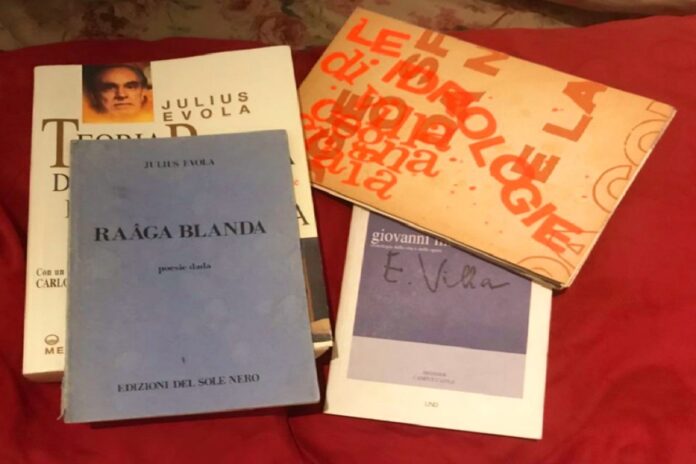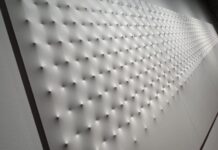Evola and Villa
A possible relationship, in the name of Dada and in the context of Italian poetry, is the one between Julius Evola (1898-1974) and Emilio Villa (1914-2003), which is also as an expression of permanent avant-garde. The first is the main exponent of Italian Dadaism. The second is a relevant figure that can be framed in the Neo-Dada.
A good part of their “last life” is lived in Rome. Evola’s poetic history centers on the early years. Instead, Villa’s one extends throughout his life.
Tuzet’s opinion
The two authors can therefore be considered “the only Dadaists in Italian poetry”: as noted by Giovanni Tuzet, professor of philosophy law, in ‘Atelier’ n. 45, March 2007. I quote this text because I share the link. Evola, despite multiple personal relationships, is disinterested in his own advertising:
“As for the ostracism of which they are actually the object in the so-called big press and in the cliques that control it, we must start from the premise that (…) the ideas that I defend, the values that I recall, can only talk to a minority ».
Tuzet writes that «Villa’s human and poetic story is not known, if not among his followers, given his reluctance to appear in official guise, to publish canonically, to promote himelf. (…) Pointing out the similarities between the two artists is not without interest since this could add something else to the history of the Italian avant-garde ».
I consider Julius Evola’s poem a borderline text, as his word also lives in other expressions of his. The author himself refuses to distinguish and separate the most significant moments of their cultural path: «Who has only one means of expression, is not an artist…”.
I have dealt with his poetry in some essays. For example, in “Theory and practice of avant-garde art” (Ed. Mediterranee, 2018) and “Studi Evoliani 2020” (Ed. Ritter, 2021). My active interest in Evola as an artist and poet begins by curating a personal art exhibition dedicated to him with documentation, in Reggio Calabria (Castello Aragonese) in 2005-06.
On writings
As for Villa’s poetics, visual and theoretical writing, I contributed with various publications and exhibitions, thanks to the collaboration of Giorgio Cegna. In the early 1980s, I consulted the author by telephone to include him in my anthology titled Nuovi Segnali (Maggioli ed., 1984). It was about verb-visual poetics in Italy, as I consider him a precursor, together with Carlo Belloli. He says: «I am dust. Can the dust be oxidized? ». I tell him that the dust can however be remembered through its passage. In this anthology I include, in addition to his visual writings, his visionary poetic translation of Tommaso da Celano’s Dies Irae (Nando Taccone Ed., 1980):
“Oh, that late day
the world opens up all around
wakes up at the Collapse. ” (E. Villa)
There are several “similarities” between the two authors. They represent an important cross-section of the history-wandering of the Italian literary avant-garde, expressing innovations and trespassing of the word. I believe that the possible links between them are different also believe that both recognize themselves in the dada matrix.
For example, they have in common the crossing of Futurism.The first point of contact, in the poetic field, is the linguistic visionary, seeking extreme assonances, including through multilingual values (such as the use of the French language).
“All these strange black crystals lost in the night / fallen fragments of distant worlds of immense worlds of distant worlds (…) (always that great dark weight in the sky)” (J. Evola)
“The howl that unhinges you is like any breath, the energetic breath of symbolic survival, described in the sup-telluric of crude anatomies of the incident of the lapsed of the involved ibi et ubique “(E. Villa)
On art
A second convergence is in the dialectic of the word with the image becoming Art, verb-visual (alchemical in Evola, anarchist in Villa).Another significant convergence can be found in the transfer of theoretical thought into the same poetic text. I presented their work-documentation in Eros Word of Art, title of an extensive exhibition that I curated on the subject in Lecce (‘N. Bernardini’ Provincial Library) in2010.
Their word becomes eros through the body of poetry and art, which implies the poetry of thought. Villa is present with his wish-cards and allusive liquid spheres of speech. Evola’s book on the Metaphysics of Sex (1958) becomes a reference for his nudes of a woman and for some of his poems, as in Ballad in red:
“I want to drink from the crater of a delirium (…) / blades of cruelty and extreme voluptuousness in my ballad in red for you / tonight / for you closed enemy beauty swathed in elegance against which absurd desires break / tonight the ritual will break you (…) »(J. Evola).
Conclusions
Evola suggests subsequent experiences of an alchemical-ritual vocation. Villa is considered oday a precursor of the literary neo-avant-gardes of the 1960s and 1970s, albeit sometimes expressed in a “mental” way: like the Novissimi and the ’63 Group, in linear poetry; certain verb-visual poetics.
Their influences, “clandestine” for some time, are then gradually accepted. Today they are often celebrated by epigones with questionable self-juxtapositions. Giovanni Tuzet writes about it: «I believe, in conclusion, that the worst way to pay homage to libertarians is by consecrating them, by imitating their ways and forms, of wanting to apply them out of context, by following the letter rather than the spirit. The best way to follow them, paradoxically, is to betray them ».
The avant-gardes have opened up the possibilities of linguistic expression. Tristan Tzara, founder of Dada says: «Let everyone cry out: there is a great destructive, negative work to fulfill. Sweep away, clean up. (…) Without purpose or design, without organization, indomitable madness, decomposition».This cross-section of permanent avant-garde poetry-art, in the name of Dada, awaits one complete reinterpretation of its peculiarities and influences. Julius Evola and Emilio Villa are bound to be, however, contagious presences.
Il complesso rapporto col dadaismo
Evola e Villa
Un possibile rapporto, nel nome del Dada e nell’ambito della poesia italiana, è quello fra Julius Evola (1898-1974) ed Emilio Villa (1914-2003), anche come espressione di avanguardia permanente. Il primo è il principale esponente del Dadaismo italiano. Il secondo è una rilevante figura che può essere inquadrata nel Neo-Dada.
Una buona parte della loro “vita ultima” è vissuta a Roma. La storia poetica di Evola s’incentra negli anni giovanili, quella di Villa si estende per tutta la sua vita.
L’opinione di Tuzet
I due autori possono essere considerati, dunque, “i soli dadaisti nella poesia italiana”: come rileva Giovanni Tuzet, docente di filosofia diritto, su ‘Atelier’ n. 45, marzo 2007. Cito questo testo perché condivido il collegamento. Evola, nonostante molteplici rapporti personali, è disinteressato alla propria pubblicizzazione:
«Per quel che riguarda l’ostracismo di cui sono effettivamente l’oggetto nella cosiddetta grande stampa e nelle cricche che la controllano, bisogna partire dalla premessa che (…) le idee che io difendo, i valori che io rievoco, non possono parlare che ad una minoranza».
«Di Villa – scrive Tuzet – non è notoria la vicenda umana e poetica, se non presso i suoi cultori, data la ritrosia dello stesso ad apparire in vesti ufficiali, a pubblicare canonicamente, a promuoversi. (…) segnalare le somiglianze fra i due non è privo di interesse, se può aggiungere un tassello alla storia delle avanguardie italiane».
Considero la poesia di Julius Evola un testo sconfinante, in quanto la sua parola vive anche in altre sue espressioni. Lo stesso autore rifiuta di distinguere e separare i momenti più significativi del proprio percorso culturale: «Chi possiede un solo mezzo espressivo, non è artista…». Della sua poesia mi sono occupato in alcuni saggi. Ad esempio, in “Teoria e pratica dell’arte d’avanguardia” (Ed. Mediterranee, 2018) e “Studi Evoliani 2020” (Ed. Ritter, 2021). Il mio interesse attivo per Evola come artista e poeta inizia con la cura della sua mostra personale di arte con documentazione a Reggio Calabria (Castello Aragonese) nel 2005-06.
Sulla scrittura
Per quanto riguarda la scrittura poetica, visuale, teorica di Villa l’ho fatto in diverse pubblicazioni ed esposizioni, grazie alla collaborazione di Giorgio Cegna. Interpello l’autore per telefono, nei primi anni ’80, per inserirlo nella mia antologia Nuovi Segnali (Maggioli ed., 1984) sulle poetiche verbo-visuali in Italia, in quanto lo considero un precursore di queste, insieme a Carlo Belloli.
Mi dice: «Io sono polvere. Si può ossidare la polvere?». Io gli rispondo che la polvere può essere però ricordata attraverso il suo passaggio. Nell’antologia includo, oltre a sue scritture visuali, anche la sua visionaria traduzione poetica del Dies Irae di Tommaso da Celano (Nando Taccone Ed., 1980):
«oh, quel giorno fondo
d’intorno s’apre il mondo
si sveglia allo Sprofondo.» (E. Villa)
Diverse sono le “somiglianze” fra i due autori. Essi rappresentano uno spaccato importante della storia-erranza dell’avanguardia letteraria italiana, esprimendo innovazioni e sconfinamenti della parola. Ritengo che i possibili collegamenti fra di loro siano diversi, oltre a riconoscersi nella matrice dada.
Per esempio, hanno in comune l’attraversamento del Futurismo. Il primo punto di contatto, in ambito poetico, è la visionarietà linguistica, ricercante estreme assonanze, anche attraverso le valenze plurilinguistiche (come l’uso della lingua francese).
«tutti questi strani cristalli neri sperduti nella notte/ frammenti caduti di lontani mondi di immensi mondi di lontani lontani mondi (…) (sempre quel gran peso oscuro nel cielo)» (J. Evola)
«è come un qualunque respiro l’ululato che ti scardina, il fiato energico della sopravvivenza simbolica, descritta nel sup-tellurico delle crude anatomie dell’accaduto del decaduto del coinvolto ibi et ubique» (E. Villa)
Sull’arte
Una seconda convergenza è nella dialettica della parola con l’immagine che diviene Arte, verbo-visuale (alchemica in Evola, anarchica in Villa). Un’altra significativa convergenza è rintracciabile nel trasferimento del pensiero teorico nello stesso testo poetico.
Presento la loro opera-documentazione in Eros Parola d’Arte, titolo di un’ampia esposizione che curo sul tema a Lecce (Biblioteca Provinciale ‘N. Bernardini’) nel 2010. La loro parola diviene eros attraverso il corpo della poesia e dell’arte, che sottintende quello del pensiero.
Villa è presente con le sue carte-desiderio e con le allusive sfere liquide di parola. Il libro di Evola sulla Metafisica del sesso (1958) diviene riferimento per i suoi nudi di donna e per alcune sue poesie, come in Ballata in rosso:
«voglio bere dal cratere di un delirio (…)/ lame della crudeltà e di voluttà estreme nella mia ballata in rosso per voi/ stasera/ per voi chiusa bellezza nemica fasciata di eleganze contro cui si frangono assurde brame/ questa sera il rito vi spezzerà (…)» (J. Evola).
Conclusioni
Evola suggestiona successive esperienze di vocazione alchemico-rituale. Villa è considerato oggi un precursore di neo-avanguardie letterarie dei decenni ‘60 e ’70, anche se talvolta espresse con modalità “mentale”: come i Novissimi e il Gruppo ‘63, nella poesia lineare; certe poetiche verbo-visuali. Le loro influenze, “clandestine” per diverso tempo, sono poi, un po’alla volta accettate.
Oggi sono celebrate spesso da epigoni con discutibili auto-accostamenti. Scrive al riguardo Giovanni Tuzet: «Credo, per concludere, che il peggior modo di rendere omaggio ai libertari sia quello di consacrarli, di imitarne i modi e le forme, di volerli applicare fuori contesto, di seguirne la lettera anziché lo spirito. Il miglior modo di seguirli, paradossalmente, è tradirli».
Le avanguardie hanno aperto le possibilità dell’espressione linguistica. Afferma Tristan Tzara, iniziatore del Dada: «Che ognuno gridi: vi è un gran lavoro distruttivo, negativo, da compiere. Spazzar via, ripulire. (…) Senza scopo né disegno, senza organizzazione, la follia indomabile, la decomposizione». Questo spaccato di poesia-arte di avanguardia permanente, in nome del Dada, aspetta una completa rilettura delle sue peculiarità e influenze. Julius Evola ed Emilio Villa risultano comunque presenze contagiose.








